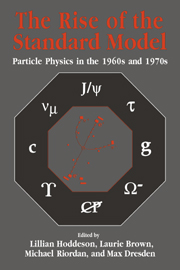Book contents
- Frontmatter
- Contents
- Contributors
- Editors' Acknowledgments
- Photographs of the Symposium
- Abbreviations and Acronyms
- Mathematical Notation
- Part One Introduction
- Part Two Quarks and Leptons
- 4 From the Psi to Charmed Mesons: Three Years with the SLAC–LBL Detector at SPEAR
- 5 The Discovery of the Tau Lepton
- 6 The Discovery of the Upsilon, Bottom Quark, and B Mesons
- 7 The Discovery of CP Violation
- 8 Flavor Mixing and CP Violation
- Part Three Toward Gauge Theories
- Part Four Accelerators, Detectors, and Laboratories
- Part Five Electroweak Unification
- Part Six The Discovery of Quarks and Gluons
- Part Seven Personal Overviews
- Index
4 - From the Psi to Charmed Mesons: Three Years with the SLAC–LBL Detector at SPEAR
Published online by Cambridge University Press: 03 February 2010
- Frontmatter
- Contents
- Contributors
- Editors' Acknowledgments
- Photographs of the Symposium
- Abbreviations and Acronyms
- Mathematical Notation
- Part One Introduction
- Part Two Quarks and Leptons
- 4 From the Psi to Charmed Mesons: Three Years with the SLAC–LBL Detector at SPEAR
- 5 The Discovery of the Tau Lepton
- 6 The Discovery of the Upsilon, Bottom Quark, and B Mesons
- 7 The Discovery of CP Violation
- 8 Flavor Mixing and CP Violation
- Part Three Toward Gauge Theories
- Part Four Accelerators, Detectors, and Laboratories
- Part Five Electroweak Unification
- Part Six The Discovery of Quarks and Gluons
- Part Seven Personal Overviews
- Index
Summary
As I look back at the first three years or so at SPEAR, I consider this one of the most revolutionary, or perhaps the most revolutionary, experiment in the history of particle physics. It was certainly the most exciting time – in a laboratory, that is – that I have ever experienced. In this chapter I discuss the period 1973–76, which saw the discoveries of the ψ and ψ′ resonances, the χ states and most of the psion spectroscopy, the D0, D+ charmed meson doublet, and the D*0 and D*+ doublet. I will also refer briefly to some more recent results.
Most of these discoveries were made with the SLAC-LBL Magnetic Detector – or, as it later became known, the MARK I – that we operated at SPEAR from 1973 to 1976. The groups involved in this work were led by Burton Richter and Martin Perl of SLAC and by William Chinowsky, Gerson Goldhaber, and George Trilling of LBL.
The discovery of the ψ
Some of my personal reminiscences regarding the weekend of the ψ discovery have already been published and I will only allude to them briefly here.
Our first task was to learn how our detector behaved in the SPEAR environment. For this purpose we developed two independent analysis systems, one at LBL and the other at SLAC. The overall data acquisition was due to Martin Breidenbach.
- Type
- Chapter
- Information
- The Rise of the Standard ModelA History of Particle Physics from 1964 to 1979, pp. 57 - 78Publisher: Cambridge University PressPrint publication year: 1997
- 2
- Cited by

